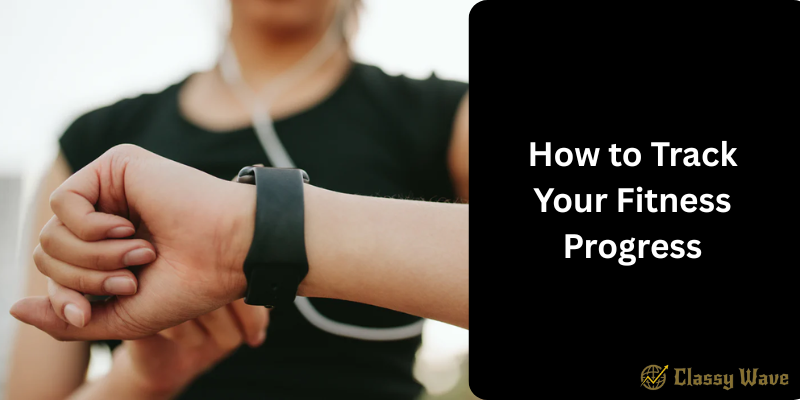How to Track Your Fitness Progress | Classy Wave
Tracking your fitness progress is the secret to staying motivated, identifying what works, and achieving your health goals faster. Whether you’re trying to lose weight, gain muscle, or just feel healthier, monitoring your progress helps you make informed decisions. Without tracking, you’re simply guessing — and guessing rarely leads to consistent results.
Why Tracking Your Fitness Progress Matters
Keeping track of your progress gives you a clear picture of how your body and performance are improving. It helps you celebrate small wins and adjust your workout or diet plan when needed. Imagine starting a journey without a map — that’s what exercising without tracking feels like. Monitoring your fitness gives you direction and purpose.
Set Clear and Measurable Goals
Before you start tracking, define your goals. Be specific — instead of saying “I want to get fit,” try setting measurable targets like:
- Lose 5 kg in two months
- Run a 5K in under 30 minutes
- Do 20 push-ups without stopping
When your goals are specific, tracking becomes easier and more effective.
Use a Fitness Journal or App
A fitness journal or app helps you stay consistent. You can record workouts, meals, steps, and progress photos all in one place.
Some popular fitness apps include:
- MyFitnessPal: For tracking calories and meals
- Fitbod: For strength training routines
- Strava: For runners and cyclists
- Google Fit or Apple Health: For general fitness tracking
Writing things down not only keeps you accountable but also makes you proud when you look back and see how far you’ve come.
Take Progress Photos
Numbers don’t always tell the full story. Your body composition can change even when the scale doesn’t move. Taking progress photos every 2–4 weeks helps you visually see muscle growth, fat loss, and posture improvements.
Tip: Take photos in the same lighting, outfit, and pose for accurate comparisons.
Measure Body Metrics
Instead of relying only on your weight, measure other key areas:
- Waist, hips, and thighs – for fat loss tracking
- Arms and shoulders – for muscle gain progress
- Body fat percentage – to monitor composition changes
You can use a simple tape measure or smart scale that calculates body fat, muscle mass, and water weight.
Track Workout Performance
Improvements in strength, endurance, and flexibility are strong signs of progress.
Here’s what you can track:
- Reps and sets: Are you lifting heavier or doing more repetitions?
- Running or cycling speed: Are your times improving?
- Flexibility: Can you stretch further or hold poses longer?
Keeping these records helps you notice even the smallest improvements.
Monitor Your Nutrition
Your diet plays a crucial role in achieving fitness goals. Track what you eat daily, focusing on calories, macronutrients (carbs, protein, fats), and hydration.
Using apps like MyFitnessPal makes this easy. Remember: 70% of your results come from nutrition, while 30% comes from workouts.
Use Wearable Fitness Trackers
Fitness trackers and smartwatches are game-changers. Devices like Fitbit, Garmin, or Apple Watch can record your heart rate, sleep, calories burned, and steps taken.
You can analyze trends, set activity goals, and stay consistent with daily reminders.
Track Your Energy and Mood Levels
Fitness isn’t just about physical changes — it’s also about how you feel.
Keep notes on your:
- Energy levels throughout the day
- Sleep quality
- Mood after workouts
If you feel more energized, sleep better, and stay happier, your routine is working — even if the scale doesn’t move much.
Check Your Resting Heart Rate
A lower resting heart rate usually means improved cardiovascular health. You can measure it manually or through a smartwatch. Track it weekly — if it’s decreasing, your heart is getting stronger.
Evaluate Sleep Quality
Sleep directly affects your recovery and performance. Poor sleep slows muscle growth and increases stress.
Use sleep-tracking apps or smartwatch features to monitor:
- Total sleep duration
- Deep vs. light sleep
- Nighttime awakenings
Aim for 7–9 hours of quality sleep every night.
Reassess Every 4–6 Weeks
Progress doesn’t happen overnight. Recheck your measurements, photos, and performance every 4–6 weeks. This gives your body enough time to adapt and show visible changes.
If progress stalls, make small adjustments to your workouts or nutrition instead of giving up.
Celebrate Small Wins
Every step counts. Whether it’s running a minute longer, lifting an extra 5 pounds, or fitting into old jeans — celebrate it. Rewarding yourself keeps motivation high and builds positive momentum.
Don’t Compare Your Progress with Others
Everyone’s body is unique. Comparing yourself to someone else can discourage you. Focus on your personal journey — the only competition is who you were yesterday.
Conclusion
Tracking your fitness progress is the key to turning your goals into achievements. It keeps you consistent, motivated, and aware of what’s working best for your body. Remember, fitness is a marathon, not a sprint — small, steady improvements lead to long-term success. Start tracking today, and you’ll be amazed at how much progress you can make!







